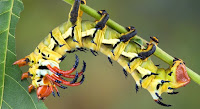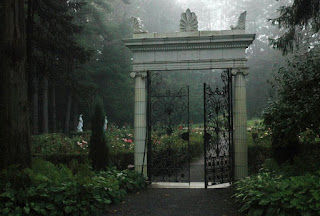1) Assassin Bugs (Zelus renardii) – We sell oodles of these all day on our site. Their aggressive homicidal tendencies make them especially effective predators for many soft-bodied insect pests. For more about them, check out their page here.
 |
| Coffin Cutter |
Satan's horses, no rinky-dink ginks,
Are huge bugs, glossed with devilish inks.
Devil's coach-horses (grubbers
And hunters); and lubber
(His horses) can also spew stinks.
 |
| Cow Killer |
 |
| Death's Head Moth |
4) Death’s Head Moth (Acherontia spp) - AKA: Hawk Moth, Death Moth. Many people are familiar with this moth; it played a role in the movie Silence of the Lambs. Apparently this formidable-looking creature loves honey and has a sweet little squeaky voice (something like if a cross between a rabbit and a cicada). Having a voice is fairly uncommon in moths, enough so that scientists have been studying it. Here is a quick read on what they’ve learned – and there is also an audio clip of the voice.
 |
| Ear Cutter |
5) Ear Cutter – Dragonfly – AKA: Ear Sewer, Ear Needle, Devil’s Dragon, Horse Stinger, Mule Killer, Bee Butcher. According to this article, these are just some of the regional names used for dragonflies in the US. The myths surrounding dragonflies are much more extensive, and darker, than I ever knew.
 |
| Hickory Horned Devil |
7) Stump Stabber (Megarhyssa macrurus) –AKA: Giant Ichneumon Wasp. Though small (about 2” long) the females of this parasitoid wasp species have the longest known ovipositors at twice the length of their bodies. Although they look like scary stingers, they are for depositing eggs – oh, and drilling. These wasps seek out insect hosts under the wood of stumps and trees and, once she finds the right one, she drills a hole down to them and lays her eggs in their nest. Here are some great pictures and even a video of her in action. I guess the male Stump Stabbers just go by Mr. Stump Stabber.
8) Toe Biters (Lethocerus americanus) - AKA: Giant Water Bug, Indian Toe Biters, Alligator Ticks. These large (up to 2½”) beetles are native to North America and are very common in both manmade and natural bodies of water. Watch out for them in the shallows - when disturbed, they do bite. Toes are usually the victims of these bites as people step on or near enough to them. Although the bite will not cause lasting damage, it does produce burning pain, swelling and even skin discoloration. If you want to see the same guy that was willing to take a Cow Killer sting getting bit by a Toe Biter, check him out here.
9) Vampire Moth (genus Calyptra) – If, when you think of moths you think of delicate little things fluttering helplessly around your porch light, you may want to reconsider your thinking. Because there really are moths that are vampires - yes, some moths actually pierce the skin of verterbrates (including humans) and lap up the blood. Scientists are still determining just how many of the 17 species in this genus are blood-eaters (so far it’s 8-10), but since only two species are here in the US, you probably don’t have to worry about them. But, you never know…Here’s more on them and here’s a video of the little blood lovers.
 10) Witch’s Horse (Anisomorpha spp) – AKA: Devil’s Riding Horse, Devil’s Darning Needle, Spitting Devil.These bugs are North American members of the extensive stick insect family. During mating, the males can be seen “riding” on the backs of the females, which may explain some of the
10) Witch’s Horse (Anisomorpha spp) – AKA: Devil’s Riding Horse, Devil’s Darning Needle, Spitting Devil.These bugs are North American members of the extensive stick insect family. During mating, the males can be seen “riding” on the backs of the females, which may explain some of the horse references. But, the Spitting Devil moniker is more accurate. These guys emit well-aimed sprays of a noxious-smelling, burning liquid as a self-defense mechanism and they aren’t hesitant to shoot. A direct hit to the eye can cause serious damage and the fumes alone have respiratory effects. It’s best to let these horses pass unhindered.



















